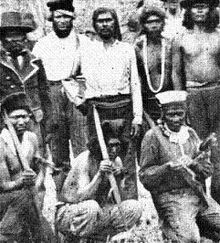Loading AI tools
Native American group in California, United States From Wikipedia, the free encyclopedia
The Yuki (also known as Yukiah) are an indigenous people of California who were traditionally divided into three groups: Ukomno'om ("Valley People", or Yuki proper),[2] Huchnom ("Outside the Valley"),[3] and Ukohtontilka or Ukosontilka ("Ocean People", or Coast Yuki).[4] The territory of these three groups included Round Valley and much of northern Mendocino County and Lake County. Today they are enrolled members of the Round Valley Indian Tribes of the Round Valley Reservation. The exonym "Yuki" may derive from the Wintu word meaning "foreigner" or "enemy."[5]
 Yuki men at the Nome Cult Farm, ca. 1858 | |
| Total population | |
|---|---|
| 569 alone and in combination[1] (2010) | |
| Regions with significant populations | |
| Languages | |
| English, formerly Yuki | |
| Related ethnic groups | |
| Wappo people |
Yuki tribes are thought to have settled as far south as Hood Mountain in present-day Sonoma County.
In 1856, the US government established the Indian reservation of Nome Cult Farm (later to become Round Valley Indian Reservation) at Round Valley.[6] It forced thousands of Yuki and other local tribes onto these lands, often without sufficient support for the transition. These events and tensions led to the Mendocino War (1859), where militias of white settlers killed hundreds of Yuki and took others by force to Nome Cult Farm.[7]

The Yuki language has been extinct since its last speaker, Arthur Anderson, died in 1983.[8] It is distantly related to the Wappo language,[9] forming the Yukian family with it. The Yuki people had a quaternary (4-based) counting system, based on counting the spaces between the fingers, rather than the fingers themselves.[10]
Scholarly estimates have varied substantially for the pre-contact populations of most native groups in California, as historians and anthropologists have tried to evaluate early documentation. Alfred L. Kroeber estimated the 1770 population of the Yuki proper, Huchnom, and Coast Yuki as 2,000, 500, and 500, respectively, or 3,000 in all.[11] Sherburne F. Cook initially raised this total slightly to 3,500.[12] Subsequently, he proposed a higher estimate of 9,730 Yuki.[13]

According to the research of Benjamin Madley, "the Yuki suffered a cataclysmic population decline under United States rule. Between 1854 and 1864, settlement policies, murders, abductions, massacres, rape-induced venereal diseases, and willful neglect at Round Valley Reservation reduced them from perhaps 20,000 to several hundred."[7] In his work, Madley argues that Yuki history constitutes a clear-cut example of genocide. He cites the fact that there is no evidence of any epidemic that would have caused such drastic population decline among the Yuki between 1854 and 1864, other than venereal diseases originating from European settlers.[7] His research thus challenges the idea that the indirect effects of European colonization were the leading cause of population decline and mass death for Native Americans.
E.N. Anderson a professor of Anthropology at the University of California at Riverside writes that the extermination of the Yuki, a helpless colonized people, was a genocidal massacre.[14]
Intermarriage among neighboring tribes after their forced relocation to the Round Valley Reservation resulted in large numbers of Native Americans with mixed ancestry.[15] Many of these people are descendants of many local tribes and have come to be called Round Valley Indian Tribes.
In the 2010 census, 569 people claimed Yuki ancestry. 255 of them were full-blooded.
Yuki people use the large roots of Carex plants to make baskets.[16]
Seamless Wikipedia browsing. On steroids.
Every time you click a link to Wikipedia, Wiktionary or Wikiquote in your browser's search results, it will show the modern Wikiwand interface.
Wikiwand extension is a five stars, simple, with minimum permission required to keep your browsing private, safe and transparent.